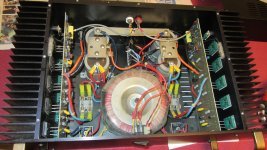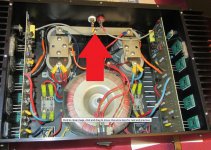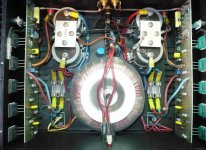Just beginning my education in such things so stay with me. Hopefully someone can shed some light on a Forte Model 3 to 1a conversion or modification of some sort. I'm looking at a Forte Model 3 which has been stated "to be modified to run in class A a little longer" through bias adjustment to 50W and then over to A/B up to the amps rated 8 ohm output. Sounds like a pho 1a conversion with A/B function, so its not a full class A conversion? Can this be done with maintaining A/B functionality through bias adjustment alone? Also, communications offer no mention of changing transformer taps, lowering voltage or any other mods, just bias. I've read much on this forum and much has been posted on this conversion in general. Being a novice and what I've read this doesn't seem possible. But then again I may be totally off base and with what I know.......? Not being a position to test/measure anything other than audition the unit is there any thing physical to look at that would provide additional info? Thanks for any help on this.
Can you post a picture of the internals of the Forte 3?
The reason I ask is that in order for the 1a conversion to work the voltage of the DC rails has to be lowered substantially, in half actually as compared to the Model 3. This is done by modifying the connections of the transformer and removing a ground bar on located at the rear of the capacitors. A picture will tell us if this modification was done or not. If the voltage was not changed then there is no way the amplifier will be putting out 50W of Class A power. Not without being able to fry eggs on the heatsinks anyway.
The reason I ask is that in order for the 1a conversion to work the voltage of the DC rails has to be lowered substantially, in half actually as compared to the Model 3. This is done by modifying the connections of the transformer and removing a ground bar on located at the rear of the capacitors. A picture will tell us if this modification was done or not. If the voltage was not changed then there is no way the amplifier will be putting out 50W of Class A power. Not without being able to fry eggs on the heatsinks anyway.
Should be possible I'll contact the seller. Your response brings up another concern that if indeed the bias was adjusted to the point of being a thermal problem, what does this do for component longevity? The pics should tell the story.
I'm fairly sure that in addition to increasing the bias, you would need to utilize lower voltage taps off of the power transformer secondary. Which I believe that particular power transformer does feature.
Otherwise, the net power dissapation at idle will increase dramatically, possibly beyond that which the heat sinks are sized for maintaining output transistor safe operating area.
Otherwise, the net power dissapation at idle will increase dramatically, possibly beyond that which the heat sinks are sized for maintaining output transistor safe operating area.
No this is still a Forte Model 3. If the conversion was attempted it was done wrong.
The ground bar at the rear (arrow in attached Model 3 picture) is one quick indication of whether the conversion from a Model 3 to Model 1 was performed. In the Model 1 this bar is either removed or moved to the middle position on the capacitors. You cannot just move the ground bar though. In addition to that change wiring changes are made to the transformer to drop the voltage on the DC rails. I attached a 2nd picture showing a Model 1 in which you can plainly see the rear ground bar is gone.
If the person you're buying this amp from has adjusted the bias up to the level they have described then the heatsinks could become hot enough to quickly compromise the output stage transistors.
The ground bar at the rear (arrow in attached Model 3 picture) is one quick indication of whether the conversion from a Model 3 to Model 1 was performed. In the Model 1 this bar is either removed or moved to the middle position on the capacitors. You cannot just move the ground bar though. In addition to that change wiring changes are made to the transformer to drop the voltage on the DC rails. I attached a 2nd picture showing a Model 1 in which you can plainly see the rear ground bar is gone.
If the person you're buying this amp from has adjusted the bias up to the level they have described then the heatsinks could become hot enough to quickly compromise the output stage transistors.
Attachments
and it would be a shame considering the price of output transistors 🙁If the person you're buying this amp from has adjusted the bias up to the level they have described then the heatsinks could become hot enough to quickly compromise the output stage transistors.
So when it's mentioned that thermally the transistors could be compromised quickly, are we talking at idle no load or under load or makes no difference? Sorry if my terminology is off. The info I do have is that the modification or adjustment was done back in November 2018. They (the seller and not the tech who did the work) may be misstating the claim of achieving 50W Class A which could explain how its survived in use since being modified, or just lucky? I can see the only definitive answer would be to hard measure the bias assuming no other mods were done. I do have a thermal IR sensor so temperature checks are possible. Probably not definitive but would this be of help?
do you lend an ampermetric clamp, set it on Adc and take the consumption value of the DC rails on each side, then with the supply voltage and ohm law, you will know how much Watt you dissipate at rest
example, 1.5A x45v = 57.5VA = +/- 58w.
it is better to stop the amp before being sure that you were lucky and check the bias
example, 1.5A x45v = 57.5VA = +/- 58w.
it is better to stop the amp before being sure that you were lucky and check the bias
So when it's mentioned that thermally the transistors could be compromised quickly, are we talking at idle no load or under load or makes no difference? Sorry if my terminology is off. The info I do have is that the modification or adjustment was done back in November 2018. They (the seller and not the tech who did the work) may be misstating the claim of achieving 50W Class A which could explain how its survived in use since being modified, or just lucky? I can see the only definitive answer would be to hard measure the bias assuming no other mods were done. I do have a thermal IR sensor so temperature checks are possible. Probably not definitive but would this be of help?
If they are running the output stage at a very high temperature then even at idle with no music signal passing the output transistors can be damaged. You don't necessarily need a thermal IR sensor to know if its too hot or not. If you cannot hold your hand on the sinks without being burnt then they're much too hot. You should be able to hold you hand on them for at least a few seconds according to Mr. Pass.
Its my understanding that the Model 1's heatsinks get pretty hot when the bias is properly adjusted. The Model 3's DC voltage is twice as high so if the quiescent current (bias) was set to the same level as the Model 1 effectively double the heat load could show up on the heatsinks of the Model 3.
You are correct that the seller may be pumping their product up based on hearsay in an attempt to sell it.
Ask the seller if they can hold their hand on the heatsinks after the amp has been on for an hour.
- Status
- Not open for further replies.
- Home
- Amplifiers
- Solid State
- Forte: Failed 1a conversion?


